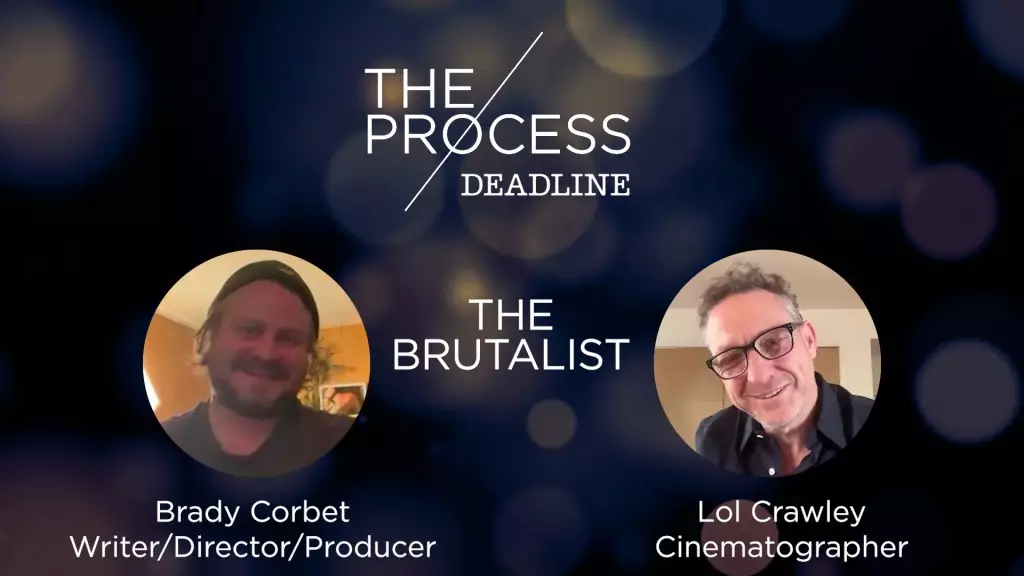In the annals of contemporary cinema, the partnership between director Brady Corbet and cinematographer Lol Crawley has blossomed into a distinguished collaboration characterized by ambition and a deep commitment to character-driven storytelling. Their latest work, “The Brutalist,” adds another chapter to their creative journey, following previous projects like “Vox Lux” and “The Childhood of a Leader.” This article delves into the intricacies of their artistic collaboration, the thematic essence of “The Brutalist,” and the challenges faced on the contentious path of filmmaking.
Corbet and Crawley have consistently engaged in a dialogue that balances ambition with introspection. In their discussions, Corbet reveals how their projects are often labeled as ambitious—a descriptor that can hold both commendations and criticisms. He acknowledges this dichotomy while expressing his view that, despite the outward appearance of vast narratives, the films are intimately focused on character development. He visually illustrates this contrast, highlighting how the scope of their films expands significantly during the pre-production phase, a process that transforms a writer’s singular vision into a collective cinematic experience.
Both Corbet and Crawley recognize the importance of collaboration during filmmaking. Corbet emphasizes that through the contributions of each department, the film evolves into a grander vision than initially conceived. This faith in the collaborative nature of cinema reveals a psychological resilience that can often be missing in a director’s psyche, especially during the uncertain pre-production stages.
Crawley adds complexity to their discussion by acknowledging the language of cinema—an intricate blend of visual aesthetics and narrative. He clarifies that the ambition Corbet dreams of has immense cinematic potential, focusing on the power of framing and performance. This conversation reflects how a single shot can encapsulate essential storytelling elements, making the spatial arrangement and actor expressions pivotal to the film’s impact.
The duo’s introspection around the concept of being “cinematic” speaks to a broader challenge within the film industry where the term often becomes an overly broad label, stripping away its artistic subtleties. Their commitment to precise language and ambitious visuals advocates for a cinematic experience that resonates deeply with viewers, fostering emotional connections that linger long after the credits roll.
While the ideals of filmmaking can seem glamorous, Corbet and Crawley offer a candid glimpse into the often grueling nature of film sets. The demanding environment, marked by long hours and relentless schedules, can breed fatigue and dissatisfaction among cast and crew members. This acknowledgment of the uncomfortable truths about the filmmaking process serves as a sobering contrast to the polished images typically associated with final film presentations.
Corbet’s commentary on the chaos of a film set, with its multitude of “angry strangers,” transcends mere humor—it emphasizes the inherent challenges and struggles of turning a creative vision into reality. Crawley expands on this idea by referencing the alienating experience of witnessing the repetitive grind of filmmaking from an outsider’s perspective. Their observations reveal a nuanced understanding of the human experience behind the camera—something audiences often overlook.
“The Brutalist” captures a moment of profound societal reflection, set in the aftermath of World War II, showcasing the life of László Tóth, a Hungarian-Jewish architect. As portrayed by Adrien Brody, Tóth’s journey is not only about architectural ambition but also about survival, hope, and the longing for family. With co-stars Felicity Jones and Raffey Cassidy, the film vividly depicts the tension and emotional struggle of waiting for a loved one trapped in a war-torn environment.
The film’s accolades, including a Golden Globe win and multiple Oscar nominations, signify its resonance with both critics and audiences. Yet these achievements are merely the surface of what “The Brutalist” embodies—an exploration of resilience, the immigrant experience, and the indelible impact of art in a fractured world.
Brady Corbet and Lol Crawley’s collaborative journey is a testament to the power of collective creativity in filmmaking. As they navigate the complexities of production, their commitment to character and ambition reflects an enduring relationship between director and cinematographer. “The Brutalist” stands as a significant contribution to their oeuvre, encapsulating the essence of post-war struggles while exploring the art of cinema itself. This intricate dance of aesthetics and emotional depth continues to fuel the duo’s endeavors, leaving audiences eagerly anticipating their next venture.

